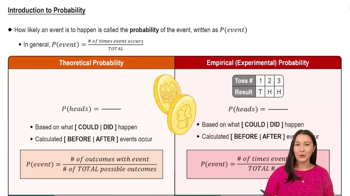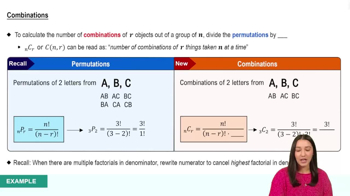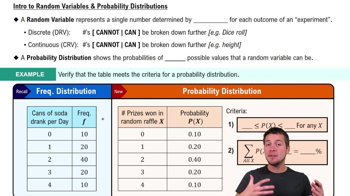28. Necklaces You are putting nine blue glass beads, three red glass beads, and seven green glass beads on a necklace. In how many distinguishable ways can the colored beads be put on the necklace?
Table of contents
- 1. Intro to Stats and Collecting Data1h 14m
- 2. Describing Data with Tables and Graphs1h 55m
- 3. Describing Data Numerically2h 5m
- 4. Probability2h 16m
- 5. Binomial Distribution & Discrete Random Variables3h 6m
- 6. Normal Distribution and Continuous Random Variables2h 11m
- 7. Sampling Distributions & Confidence Intervals: Mean3h 23m
- Sampling Distribution of the Sample Mean and Central Limit Theorem19m
- Distribution of Sample Mean - Excel23m
- Introduction to Confidence Intervals15m
- Confidence Intervals for Population Mean1h 18m
- Determining the Minimum Sample Size Required12m
- Finding Probabilities and T Critical Values - Excel28m
- Confidence Intervals for Population Means - Excel25m
- 8. Sampling Distributions & Confidence Intervals: Proportion1h 12m
- 9. Hypothesis Testing for One Sample3h 29m
- 10. Hypothesis Testing for Two Samples4h 50m
- Two Proportions1h 13m
- Two Proportions Hypothesis Test - Excel28m
- Two Means - Unknown, Unequal Variance1h 3m
- Two Means - Unknown Variances Hypothesis Test - Excel12m
- Two Means - Unknown, Equal Variance15m
- Two Means - Unknown, Equal Variances Hypothesis Test - Excel9m
- Two Means - Known Variance12m
- Two Means - Sigma Known Hypothesis Test - Excel21m
- Two Means - Matched Pairs (Dependent Samples)42m
- Matched Pairs Hypothesis Test - Excel12m
- 11. Correlation1h 6m
- 12. Regression1h 50m
- 13. Chi-Square Tests & Goodness of Fit1h 57m
- 14. ANOVA1h 57m
4. Probability
Counting
Problem 3.4.40
Textbook Question
Board of Directors The University of Colorado Board of Directors has 23 members. One member serves as board chair and another serves as vice chair. Given the names of the 23
board members, what is the probability of randomly selecting the name of the chair and the name of the vice chair? (Source: University of Colorado)
 Verified step by step guidance
Verified step by step guidance1
Step 1: Understand the problem. We are tasked with finding the probability of randomly selecting one person as the chair and another as the vice chair from a group of 23 members. This is a problem involving combinations and probabilities.
Step 2: Calculate the total number of ways to select the chair and vice chair. Since the selection is ordered (chair first, then vice chair), this is a permutation problem. The number of permutations is given by the formula: P(n, r) = n! / (n - r)!, where n is the total number of members (23) and r is the number of positions to fill (2).
Step 3: Substitute the values into the permutation formula. Using MathML, the formula becomes: . Here, n = 23 and r = 2, so the calculation is: .
Step 4: Simplify the expression. The factorials simplify to: , because the remaining terms cancel out when dividing by .
Step 5: Calculate the probability. Since there is only one specific pair of names that can be selected as the chair and vice chair, the probability is the reciprocal of the total number of permutations. This is given by: .
 Verified video answer for a similar problem:
Verified video answer for a similar problem:This video solution was recommended by our tutors as helpful for the problem above
Video duration:
4mPlay a video:
Was this helpful?
Key Concepts
Here are the essential concepts you must grasp in order to answer the question correctly.
Probability
Probability is a measure of the likelihood that a particular event will occur, expressed as a number between 0 and 1. In this context, it refers to the chance of randomly selecting specific individuals from a group. The probability of an event can be calculated by dividing the number of favorable outcomes by the total number of possible outcomes.
Recommended video:

Introduction to Probability
Combinations
Combinations refer to the selection of items from a larger set where the order does not matter. In the context of this question, it involves selecting the chair and vice chair from the board members. Understanding combinations is essential for calculating probabilities when the order of selection is irrelevant.
Recommended video:

Combinations
Random Selection
Random selection is a process where each member of a group has an equal chance of being chosen. This concept is crucial for ensuring that the probability calculations are valid, as it assumes that the selection of the chair and vice chair is unbiased and purely based on chance, without any influence from external factors.
Recommended video:
Guided course

Intro to Random Variables & Probability Distributions

 7:11m
7:11mWatch next
Master Introduction to Permutations with a bite sized video explanation from Patrick
Start learningRelated Videos
Related Practice
Textbook Question
